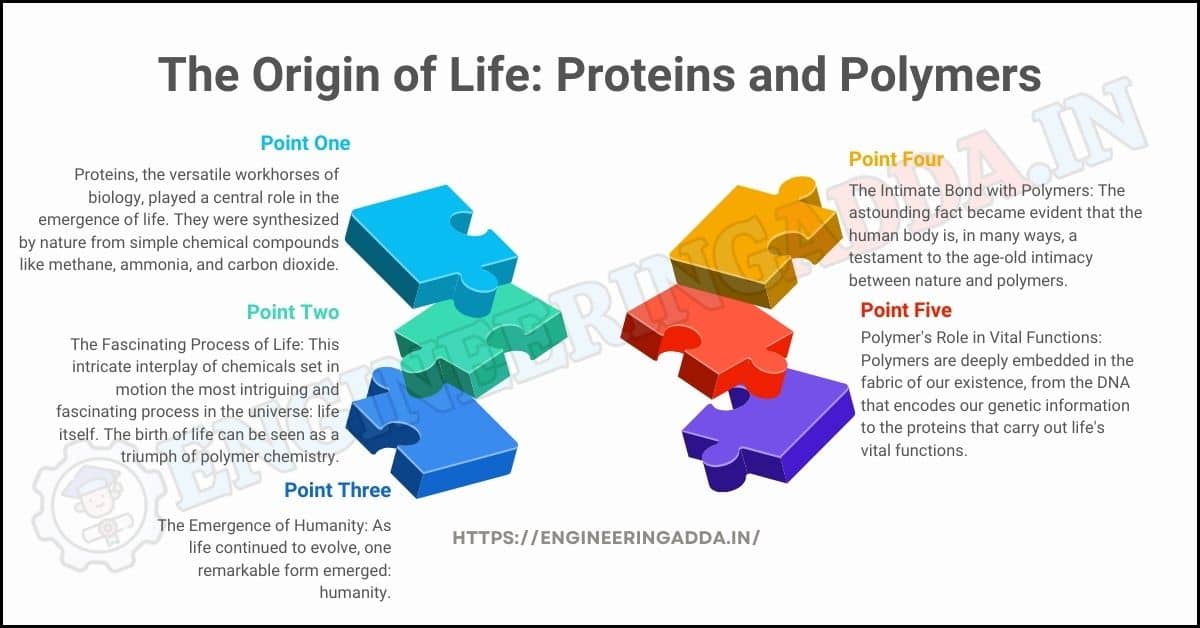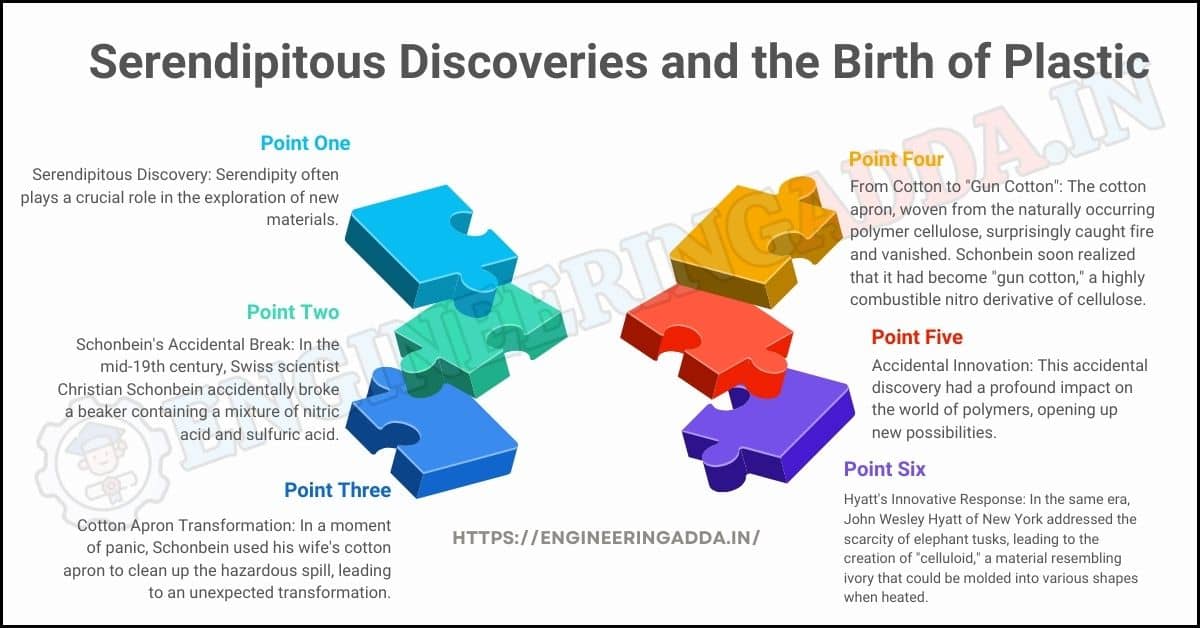Table of Contents
Introduction
The history of polymers is a rich tapestry that weaves together elements, both natural and synthetic, into a narrative that spans billions of years. This story begins with the formation of Earth over 4 billion years ago, often referred to as “Nature’s giant laboratory.” Within this laboratory, the elements—carbon, hydrogen, oxygen, and nitrogen—began to engage in an intricate dance, gradually combining to create increasingly complex molecules. These molecular combinations laid the foundation for life itself, with the material basis for life being none other than a remarkable polymer: protein.
Explore more about education.
The Origin of Life: Proteins and Polymers

Proteins, the versatile workhorses of biology, played a central role in the emergence of life. Nature, in its infinite creativity, synthesized proteins from simple chemical compounds like methane, ammonia, and carbon dioxide. This intricate interplay of chemicals set in motion the most intriguing and fascinating process in the universe: life itself. The birth of life was, at its core, a triumph of polymer chemistry.
As life evolved through the ages, one remarkable form emerged: humanity. And as it did, something astounding became evident: the human body is, in many ways, a testament to the age-old intimacy between nature and polymers. From the DNA that encodes our genetic information to the proteins that carry out life’s vital functions, polymer are deeply embedded in the fabric of our existence.
Polymers in Early Human Civilization
The human story is inexorably linked to polymer. Since time immemorial, early humans recognized the vital role that polymers in their natural forms played in their survival. These natural polymers included wood, cotton, cellulose, starch, and more. The fundamental needs of early humans have remained surprisingly consistent throughout the ages: the need for clothing, shelter, and defense.
Early humans, driven by the instinct to survive, ingeniously employed natural polymers to meet these needs. They donned clothing made from animal skins, constructed shelters from leaves and trees, and crafted weapons from wood. These early humans, like us, were intimately acquainted with polymers, though they interacted with them in their natural state.
The Emergence of Synthetic Polymers
Fast-forward to the 15th century, where a world-changing encounter took place. Christopher Columbus, the renowned explorer, observed natives in South America engaged in a playful game involving a solid, rubbery substance derived from the exudate of a tree they called “weeping wood.” Little did they realize that their bouncing game would be the humble beginning of a multi-billion-dollar industry: the rubber Textile Industry. This encounter marked the first foray into the synthetic production of Macromolecules on a significant scale.
Years later, in the 19th century, a scientist named Joseph Priestley stumbled upon a peculiar property of this rubbery substance: it could effectively erase pencil marks from paper. This property earned the material its name: rubber.
Serendipitous Discoveries and the Birth of Plastic

Serendipity often plays a vital role in the discovery of new materials. Christian Schonbein, a Swiss scientist in the mid-19th century, broke a beaker containing a mixture of nitric acid and sulfuric acid. In his moment of panic, he hastily grabbed his wife’s cotton apron to mop up the hazardous spill. What ensued was both unexpected and transformative: the cotton apron, a textile woven from a naturally occurring polymer called cellulose, caught fire and vanished into thin air. Schonbein soon realized that the cotton had been converted into “gun cotton,” a highly combustible nitro derivative of cellulose. This accidental discovery opened new doors in the world of polymer.
The mid-19th century was marked by a growing scarcity of elephant tusks, which were, among other uses, a source of ivory for billiard balls. The situation necessitated the search for a suitable substitute for ivory. John Wesley Hyatt of New York rose to the occasion, driven by the age-old adage that necessity is the mother of invention. His innovation resulted in a material that not only resembled ivory but could also be molded into various shapes when heated. Hyatt named this material “celluloid,” which stands as a major milestone in the journey toward our modern “plastic” age.
The Emergence of Synthetic Polymers
The late 19th and early 20th centuries witnessed significant breakthroughs in the realm of synthetic polymers. Scientists, including the brilliant Leo Baekeland, ventured into the realm of polymer chemistry, exploring reactions that led to the creation of entirely new synthetic polymers. Baekeland’s pioneering work in 1909 resulted in the birth of Bakelite, a polymer that could be molded into hard, infusible articles. Bakelite served as a precursor to many of the modern synthetic Macromolecules we are familiar with today.
In 1912, Jacques Brandenburger introduced another game-changing material: cellophane. This transparent wonder further expanded the horizons of polymer applications. Within a decade, polymers began to appear in ever newer forms, each with increasingly impressive properties, thanks to the dedicated efforts of scientists around the world.
The Impact of Modern Polymers
Although synthetic polymers appeared later in human history than inventions like the radio and the airplane, their impact on our lives is immeasurable. Whether we are seeking fancy decoration articles, innovative textiles, sturdy building materials, or efficient packing materials, polymers have introduced us to an astonishing array of attractive choices.
Diverse Applications of Polymers
The versatility of polymers is a marvel. These adaptable materials can take on various forms, from solid articles with impressive strength to flexible, rubber-like substances, soft and resilient foams, fine fibers, and even transparent, glass-like sheets. They can even swell to become jelly-like food materials. macromoleculesserve a myriad of functions, from bonding objects and sealing joints to filling cavities and bearing substantial loads. Their applications extend to everything from clothing the naked to powering space vehicles, and in some cases, even replacing human organs. This age can aptly be described as the “polymer age.”
The Future of Polymers
The journey of polymers has been one of continuous exploration, discovery, and innovation. They are a testament to the inquisitiveness and ingenuity of the human spirit. Polymers have not been thrust upon us suddenly; they have evolved through the dedicated work of a host of motivated scientists who have enriched human life.
Today, the depth of insight into polymer science and technology is astounding. Material scientists possess the knowledge and capability to create an almost limitless range of new materials. Much like an architect selects bricks, stones, and logs of wood in varying shapes, sizes, and patterns to construct various designs, a chemist can produce countless plastics, rubbers, foams, fibers, and more by thoughtfully combining various chemicals under desired conditions. These novel materials open doors to a world of possibilities, and we can only imagine the formidable utility combinations that will emerge in the hands of polymer chemists who continue to refine the art of “molecular architecture.”
FAQs
What are polymers, and how are they defined?
Polymers are large molecules composed of repeating structural units, often referred to as monomers. They can be found in both natural and synthetic forms and are characterized by their versatile properties and applications
How have polymers influenced modern society and daily life?
Polymers have made an indelible impact on modern society, offering a diverse range of properties, from strength and flexibility to resistance to chemicals. They are instrumental in industries like construction, packaging, and aerospace, contributing to everyday items and technological advancements.
What is the significance of the “polymer age”?
The “polymer age” signifies an era in which macromolecules have become integral to our lives, offering versatile solutions to diverse challenges. Polymers play a vital role in addressing our needs, from clothing and shelter to advanced technologies and medical applications
Natural vs. Synthetic Polymers: What’s the Difference?
Natural polymers are plant and animal-based, while synthetic polymers are chemically engineered. Natural polymers tend to biodegrade, while many synthetic ones do not.
For further insights into the ‘polymer age’ and its impact on education, visit this educational resource
Conclusion
The saga of polymers is a testament to human curiosity and ingenuity, spanning billions of years. From the primordial chemical dances that birthed life to the emergence of modern synthetic macromolecules, this journey has transformed our world. Polymers, both natural and synthetic, have become inseparable from the human experience, enhancing our lives in countless ways.
As we peer into the future, the potential for innovation in the world of polymers appears boundless. Material scientists, akin to architects of molecules, continue to explore the vast universe of polymer chemistry, unlocking new materials with extraordinary properties and applications. The story of polymers is an ever-evolving one, promising exciting chapters yet to be written.


